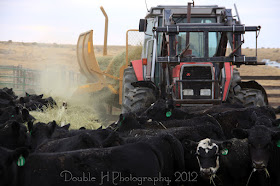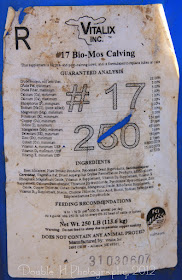These calves were taken off their mothers over a month earlier than we normally would due to the drought this year. Weaning early will allow their mothers to switch from using energy to make milk to using energy to put on condition before winter sets in, and in maintaining their new pregnancy. My dad said he can't remember ever weaning in the middle of August before.
Weaning is one of those ranch practices that is very unique on each operation. What works for one guy may not for the next due to differences in environment, weather, cattle, facilities, disease history and the number of people available to help. Here's what we did this year.
First, we do not precondition, or give any weaning shots. All these calves will be given is a 7-way booster a couple weeks after they're weaned to prevent them from contracting Blackleg. This is a pretty unique management practice, and we are able to do it successfully in part because disease is rare in our area and our cattle are not co-mingled with anyone elses. We do have a complete health program for them, and that is covered further on in this post.
When we wean, it occurs at a corral located a few miles from our house. We sort and load the calves onto our cattle pot, haul them home, and unload them. This means the cows are bawling at a set of corrals far enough away they can't be heard by the calves, and vice versa. Instead of looking for mom, we've found the calves settle down and go to eating faster than when we had the cows right outside the corral.
Keeping the calves full is among our top priorities. They are locked in a smaller pen, shown in the top photo, for the first couple days to prevent them from walking. Walking is when the calves get to walking (as if that wasn't self explanatory) around the corral. Pretty soon they're all worked up, and possibly running, instead of settling down and eating. Walking is bad, and can result in the corral being torn down, increased sickness, reduced feed intake and gain, and higher anxiety levels in the calves. These are all the opposite of what we are trying to accomplish as we wean.
After they're over the initial surprise of being weaned, and we deem they're ready based on extensive observation, we open up the corral and they're given access to a much larger area. Within this area are two bottomless feed bunks we keep full of ground grass hay. They also have access to two round bale feeders from their smaller pen, also full of grass hay. If calves are eating, they aren't thinking about mom as much, and when calves are eating they're going to be gaining. We want to get them gaining as much and as fast as possible; as ranchers we always sell pounds. Plus, full calves are happy calves, and we want them to be happy.
Every morning we fill the bottomless bunks. Just this week we had to start filling them twice a day because the calves are starting to eat a lot more. As you can see they like to eat and aren't bothered by the loud tractor and hay buster. Feeding time is also when we walk through and observe the calves for any potential problems, concerns or issues. Diligent observation can convert a potentially major issue into a minor concern a lot of the time.
We also feed lick tubs with our hay. These in the blue plastic containers are supposed to be a special weaning tub, but somehow the order was messed up and we got calving tubs instead (????)
Here's the ingredient list. Different tub varieties will have different ingredients, and levels of protein, fat, fiber. etc... All tubs provide a lot of vital nutrients and energy, and these (as in, the ones they were supposed to be) are added to the calve's ration to compliment the hay they're also consuming. We are currently switching from these to another, regular calf tub that comes in a cardboard, completely biodegradable tub. If I had the right two labels to compare, I would tell/show you the differences between the two.
Then there is the water, which is always a critical factor of any ration. Lots of readily available, clean water is essential at all times on our operation, and weaning is no different. The foam is the result of a treatment we put in the water, shown below.
We add powdered tetracycline, and Corid, to our calves water for health reasons. The tetracycline is a bright yellow powder, and the Corid is a liquid.
Here is the tetracycline label. We add this to a cistern for a set number of days to prevent respiratory problems (pneumonia) in our freshly weaned calves. In some ways, this combats the same issues that a weaning vaccination program would. In case you missed it, each tub of this costs about $85, and we have to add multiple tubs to the several thousand gallons of water the calves will drink during their time on this. It's not cheap.
Here's the Corid label. This is used in an attempt to prevent coccidiosis, which can be a very serious and fatal problem in our area. We are doing the 21-day treatment this year. These bottles cost between $95 and $110 each, and so far we've gone through over a half dozen of them. Again, not cheap, but worth it to keep the calves healthy.
We add both of these to a 7,000 gallon cistern, which we've calculated out to gallons per foot. We've also calculated how much of each additive we need to add per foot of water. This way we can turn on the cistern, add the proper amount of Corid and tetracycline, let it fill up a foot, or two or three, then turn it off and have everything mixed and ready to go. A "story pole" is how we measure the depth of the cistern. I know, almost to the minute, how long it takes the well to pump a foot of water into the cistern.
As I mentioned before, so far this year our system is working like a champ. The calves are happy, full and healthy. Nothing better than seeing a corral full of calves lounging around chewing their cuds!











Great post, it interesting how people do weaning so differently based on size and location!
ReplyDelete